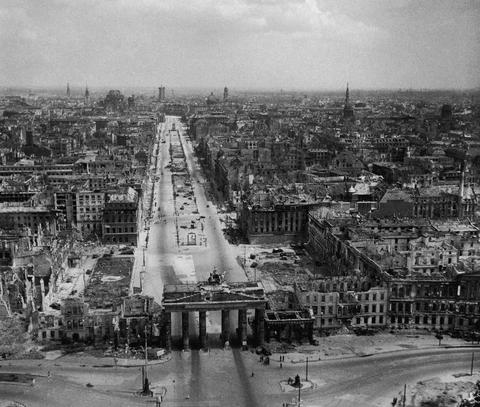The End of the Bloodiest War in History: Part IV

This final part in our series on the human cost of the Second World War in Europe will look at the nation most responsible for plunging humanity into global warfare: Germany. Though in the United States of America the Second World War is often cast today as the last "good war", in reality there were few nation's that participated in the war, willingly or not, and emerged from the war with entirely clean hands.
I make this observation because the people of Germany were both the perpetrators and, in some cases, victims of the violence Adolf Hitler's Nazi regime unleashed across all of Europe. There were good Germans, and to deny that fact is to grossly distort and simplify history. That said, there is no question that the Third Reich ranks among the most criminal regimes in human history (with the Soviet Union during Josef Stalin's reign of terror somewhat ironically, given the bloodshed Germany visited upon the Soviet people, unquestionably one of the others). Moreover, without the willing participation or willful neglect of millions of Germans Hitler never would have been able to engineer the deaths of tens of millions of Europeans during the twelve short years of the Third Reich's existence. Nevertheless, this suffering had a cost, and that is the subject of this post - the price the people of Germany paid for enabling Hitler's quest for Lebensraum.
Let us start our examination of Germany's losses during the Second World War by looking at its military establishment: the Wehrmacht. All told the Wehrmact suffered 13,488,000 casualties (3,888,000 killed in battle of succumbing to their wounds with another 1,186,000 dying in Soviet captivity) during the Second World War. Approximately 10,758,000 of these total casualties occurred in the war of racism and hatred against the Soviet Union. By 1945 one in five German men from the entire German population were either killed or wounded. One third of Germany’s boys born between 1915 and 1924, and forty percent of those born between 1920 and 1925 were dead or missing. Of the 11 million German POW’s taken during the war, three million prior to May 1945 and eight million during the final surrender, one and a half million just disappeared. The Czechs and Poles killed thousands while the Yugoslavs put them to shame – killing around 80,000 German POWs according to some estimates. In the West, the reaction to Buchenwald and the uncovering of other Nazi atrocities would spur what would become a U.S. occupation marked during its early years by a brutality largely unknown to this day. As many as 40,000 of the one million German prisoners of war held by the US Army in camps along the Rhine River would die, mostly of starvation, during the summer of 1945. In French custody 24,178 Axis prisoners of war would die – again mostly of starvation and disease with outright murder or brutality contributing to a smaller number of deaths. In comparison, in the British occupied areas of Germany 1,254 German soldiers died in post-war prisoner of war camps.
Regarding German civilian deaths, exact figures are hard to find. Nonetheless, reliable estimates are that at least 400,000 Germans civilians were killed in just 1945 from the Allied strategic bombing campaign and the land combat within German borders. Some estimate that at least 1.8 million German civilians had died by May 7, 1945. Approximately 16-20 million Germans were left homeless by the bombing and fighting on German soil. In particular the Red Army raped and murdered its way into Central and Eastern Europe with hardly any restraint. Roughly 277,000 East Prussians, 300,000 Pomeranians, and 674,000 Silesians are estimated to have lost their lives in the winter of 1944-45. In addition, the Czechs, in a pogrom that lasted well after the war’s official end, killed 230,000 Germans in the Sudetenland. Then, from 1945-1950 the Soviet Union executed 65,000-80,000 Germans. Finally, an estimated 14-16 million ethnic Germans were expelled from Eastern Europe during the war’s final months, and the following years of Soviet rule, with over one million dying of starvation, exposure, exhaustion, or murder during the brutal journey to Germany. In this cruelest irony of all Hitler had achieved his wish in racially purifying Central and Eastern Europe.
Finally, it must not be forgotten that, in addition, from 1933-1945 Hitler and his minions slaughtered 190,000 German and Austrian Jews. They also drove from Germany another 261,000 Jews prior to the war; from a pre-war population of 522,000 Jews. Austria alone witnessed 65,000 Jews murdered by the Nazi’s – from a pre-war population of 180,000 mostly Viennese Jews. Another 90,000 German Gypsies, homosexuals, mentally ill, sick, and criminal were also “euthanized”. All told, World War Two represents one of the most significant racial and ethnic reorderings of Europe in history.



Post new comment